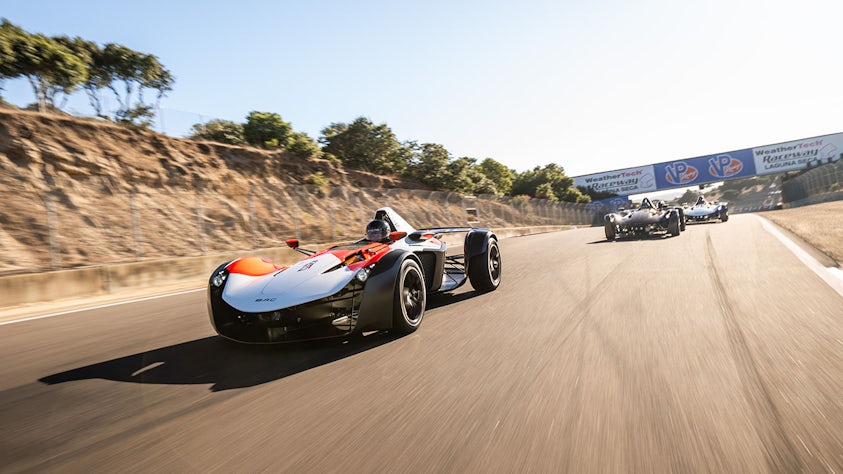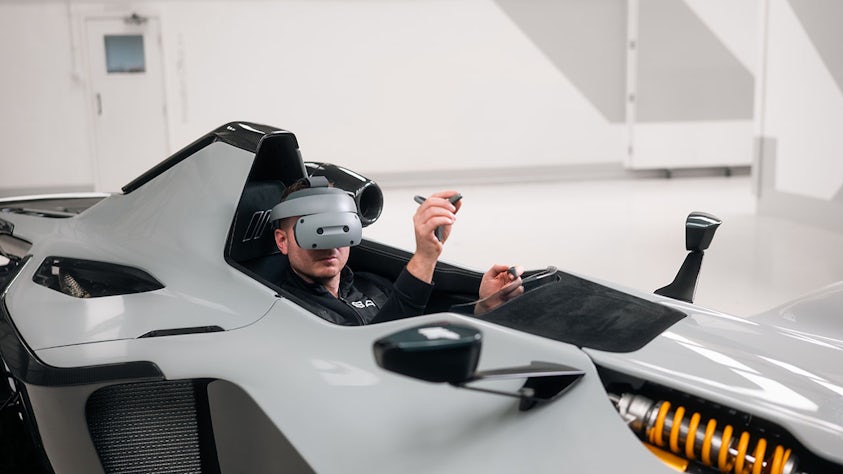June 30, 2025
Plano, Texas, USA

Briggs Automotive Company (BAC) will move to the Siemens Xcelerator portfolio of industry software and use it to develop the next generation of Mono, its single-seater road legal race car (Image credit: BAC)
BAC was founded in 2011 by Neill and Ian Briggs to fulfill their vision of a road vehicle that offers the most authentic and pure driving experience possible while implementing the very latest racing technology. Developed to be equally at home on the road as it is on the track, BAC's 570 kg Mono supercar is powered by a naturally aspirated 2.5-liter powertrain which develops 311 hp and 313 Nm of torque which translates to a power-to-weight ratio of 546 hp-per-tonne.

Briggs Automotive Company (BAC) will move to the Siemens Xcelerator portfolio of industry software and use it to develop the next generation of Mono, its single-seater road legal race car (Image credit: BAC)
When combined with optimal weight distribution and the lightweight structure featuring BAC’s world-leading graphene-infused carbon panels, the result currently allows the Mono to sprint to 60 mph in just 2.7 seconds – which the team is looking to dramatically improve for the next-generation vehicle. The need to push the boundaries of what’s achievable in the high-performance automotive industry led BAC’s senior management and design team to reevaluate its core vehicle development technologies. BAC has selected NX X from Siemens' Designcenter suite of product engineering software for the development of its next generation Mono.
"Anything that helps us be ahead of the game and be ahead of anybody else. The reason we chose Siemens’ Designcenter software to develop the next generation of Mono is because it's the best – and it gives us the tools we need to take our vision to the next level,” said Ian Briggs, design director and co-founder. “Our vision was to create a car that simply didn't exist. The fundamental principle of a sports car is choosing excitement over utility, and we took that to the nth degree. Mono is that philosophy made real—a vehicle without compromise, built to prove that being ahead of the game means refusing to compromise on the driving experience.”
Solving the challenge of homologation
One of the key drivers for the move to Designcenter is to solve the challenge serving a global customer base and certifying that a vehicle complies with the regulatory and safety standards set in a particular region or country.

A key driver for the move to Siemens Xcelerator is to solve the challenge of serving a global customer base and certifying that a vehicle complies with the regulatory and safety standards set in a particular region or country (Image credit: BAC)
As Briggs explains, “A key challenge for us is homologating the car for the global market. Understanding the specific positional requirements for everything from headlights to driver sight lines is a complex minefield. The great advantage of Designcenter is that it allows us to build that entire regulatory framework directly into our 3D CAD model, giving us new levels of confidence and a greater speed of development.”
Customer experience with Immersive Design
The BAC team are also exploring ways to enhance the customer buying and customization experience with Siemens’ immersive engineering technology - enabling customers to use immersive XR technology to experience their bespoke vehicles - all based on real-world 3D CAD data, presented in high-fidelity realism.

The BAC team are exploring ways to enhance the customer buying and customization experience with Siemens’ immersive engineering technology - enabling customers to use immersive XR technology to experience their bespoke vehicles (Image credit: BAC)
Eliott Marshall, production manager, BAC explains, “The thing that makes BAC truly unique is the bespoke elements. Siemens’ Immersive Engineering technology allows us to present to the customer exactly what they’re ordering. Being able to sit in their seat fitting jig and see all of the personal customisations they want around them, interact with them as if they’re already implemented, is going to get the fire burning within them.”
To learn more about why BAC is moving to Siemens Xcelerator and the benefits it will gain, visit https://blogs.sw.siemens.com/nx-design/bac-building-the-next-generation-supercar-with-designcenter/ or watch the video on YouTube
Siemens Digital Industries Software helps organizations of all sizes digitally transform using software, hardware and services from the Siemens Xcelerator business platform. Siemens' software and the comprehensive digital twin enable companies to optimize their design, engineering and manufacturing processes to turn today's ideas into the sustainable products of the future. From chips to entire systems, from product to process, across all industries. Siemens Digital Industries Software – Accelerating transformation.
Note: A list of relevant Siemens trademarks can be found here. Other trademarks belong to their respective owners.
Email: press.software.sisw@siemens.com
Link to Press Release
Plano, Texas, USA
- - BAC to move away from legacy toolset to overcome challenges of next-generation vehicle development and homologation in a global market
- - Road to Track car developer exploring elevation of customer buying and customization experience using Siemens’ immersive engineering capabilities

Briggs Automotive Company (BAC) will move to the Siemens Xcelerator portfolio of industry software and use it to develop the next generation of Mono, its single-seater road legal race car (Image credit: BAC)
BAC was founded in 2011 by Neill and Ian Briggs to fulfill their vision of a road vehicle that offers the most authentic and pure driving experience possible while implementing the very latest racing technology. Developed to be equally at home on the road as it is on the track, BAC's 570 kg Mono supercar is powered by a naturally aspirated 2.5-liter powertrain which develops 311 hp and 313 Nm of torque which translates to a power-to-weight ratio of 546 hp-per-tonne.

Briggs Automotive Company (BAC) will move to the Siemens Xcelerator portfolio of industry software and use it to develop the next generation of Mono, its single-seater road legal race car (Image credit: BAC)
When combined with optimal weight distribution and the lightweight structure featuring BAC’s world-leading graphene-infused carbon panels, the result currently allows the Mono to sprint to 60 mph in just 2.7 seconds – which the team is looking to dramatically improve for the next-generation vehicle. The need to push the boundaries of what’s achievable in the high-performance automotive industry led BAC’s senior management and design team to reevaluate its core vehicle development technologies. BAC has selected NX X from Siemens' Designcenter suite of product engineering software for the development of its next generation Mono.
"Anything that helps us be ahead of the game and be ahead of anybody else. The reason we chose Siemens’ Designcenter software to develop the next generation of Mono is because it's the best – and it gives us the tools we need to take our vision to the next level,” said Ian Briggs, design director and co-founder. “Our vision was to create a car that simply didn't exist. The fundamental principle of a sports car is choosing excitement over utility, and we took that to the nth degree. Mono is that philosophy made real—a vehicle without compromise, built to prove that being ahead of the game means refusing to compromise on the driving experience.”
Solving the challenge of homologation
One of the key drivers for the move to Designcenter is to solve the challenge serving a global customer base and certifying that a vehicle complies with the regulatory and safety standards set in a particular region or country.

A key driver for the move to Siemens Xcelerator is to solve the challenge of serving a global customer base and certifying that a vehicle complies with the regulatory and safety standards set in a particular region or country (Image credit: BAC)
As Briggs explains, “A key challenge for us is homologating the car for the global market. Understanding the specific positional requirements for everything from headlights to driver sight lines is a complex minefield. The great advantage of Designcenter is that it allows us to build that entire regulatory framework directly into our 3D CAD model, giving us new levels of confidence and a greater speed of development.”
Customer experience with Immersive Design
The BAC team are also exploring ways to enhance the customer buying and customization experience with Siemens’ immersive engineering technology - enabling customers to use immersive XR technology to experience their bespoke vehicles - all based on real-world 3D CAD data, presented in high-fidelity realism.

The BAC team are exploring ways to enhance the customer buying and customization experience with Siemens’ immersive engineering technology - enabling customers to use immersive XR technology to experience their bespoke vehicles (Image credit: BAC)
Eliott Marshall, production manager, BAC explains, “The thing that makes BAC truly unique is the bespoke elements. Siemens’ Immersive Engineering technology allows us to present to the customer exactly what they’re ordering. Being able to sit in their seat fitting jig and see all of the personal customisations they want around them, interact with them as if they’re already implemented, is going to get the fire burning within them.”
To learn more about why BAC is moving to Siemens Xcelerator and the benefits it will gain, visit https://blogs.sw.siemens.com/nx-design/bac-building-the-next-generation-supercar-with-designcenter/ or watch the video on YouTube
Siemens Digital Industries Software helps organizations of all sizes digitally transform using software, hardware and services from the Siemens Xcelerator business platform. Siemens' software and the comprehensive digital twin enable companies to optimize their design, engineering and manufacturing processes to turn today's ideas into the sustainable products of the future. From chips to entire systems, from product to process, across all industries. Siemens Digital Industries Software – Accelerating transformation.
Note: A list of relevant Siemens trademarks can be found here. Other trademarks belong to their respective owners.
Contacts for Press
Siemens Digital Industries Software PR TeamEmail: press.software.sisw@siemens.com
Link to Press Release
